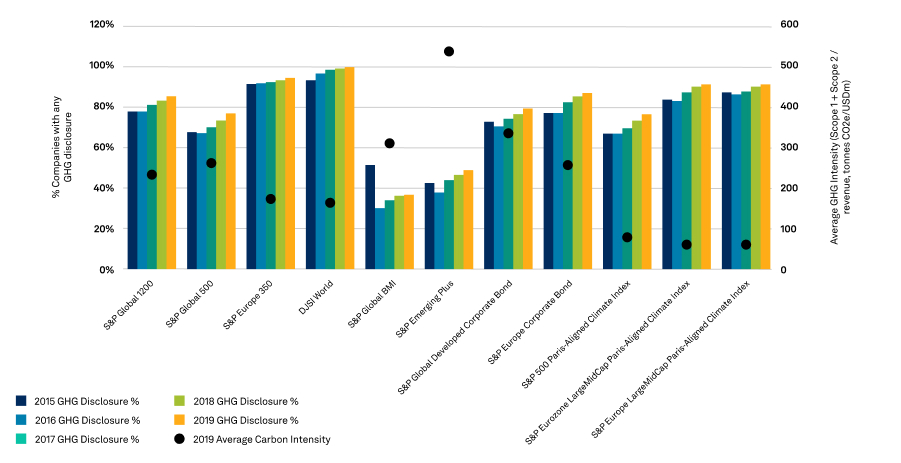S&P Global Trucost researches, standardizes and validates corporate environmental performance data covering 15,000 companies (representing 99% of global market capitalization) across six aggregated categories: Greenhouse Gases (GHGs), Waste, Water, Air Pollutants, Land/Water Pollutants and Natural Resource Use.
To review the state of today’s corporate environmental performance disclosure, all six of these categories were assessed across 11 major indices to identify where environmental information is, and is not, being reported.
Figure 1: Emerging market companies have the highest environmental intensity, but lowest disclosure

Source: S&P Global Trucost data, as of June 24, 2021. For illustrative purposes only.
The lowest disclosure rates for all environmental performance indicators were found on the S&P Global Broad Market Index (BMI) (19%) and the S&P Emerging Plus BMI1 (26%). These are the most environmentally intensive on average of all the market benchmarks reviewed (6.1% and 7.5% direct impact ratio2 compared to an average of 4.1% across all benchmarks).
Taking a deeper dive into Scopes 1 and 2 greenhouse emissions3 disclosure over time, we found a similar pattern.
Figure 2: Emerging market companies have the highest carbon intensity, but lowest disclosure

Emerging markets companies have the highest carbon intensity, but lowest disclosure. The most carbon-intensive4 index, S&P Emerging Plus BMI at 530 tCO2e/USDm, also had the lowest GHG disclosure rate at 48%. Levels of disclosure were higher in the indices that take into account environmental, social and governance (ESG) performance. For example, GHG disclosure was 98% for the Dow Jones Sustainability World Index (DJSI) and 89% for the European Paris-Aligned Climate indices, compared to 77% on average for all indices considered. It is likely that companies that disclose GHG data are making progress on improving their carbon efficiency; hence, indices with a high level of disclosure tend to have lower carbon intensities.
In terms of sectors, some of the most carbon-intensive companies are also the best disclosers. However, other sectors have a low disclosure rate and poor carbon efficiency.
Figure 3: The most carbon intensive companies lead the way on disclosure

For example, Utilities has the highest carbon intensity at 2,821 tCO2e/USDm and the highest GHG disclosure rate at 70%. However, the Energy sector has the third highest carbon intensity at 895 tCO2e/USDm, and less than half of companies in the sector disclose GHG emissions.
The Implications are Significant
Reviewing this information, the implications for financial institutions and corporations is significant; investors with holdings in carbon-intensive regions and business activities could significantly underestimate environmental risks if data gaps in disclosure are not filled, and corporations may have poor visibility on risky supply chain links.
Find out how a granular approach to completing data gaps can address the quality imperative to provide a complete picture of environmental performance across the global value chain in our next blog, Completing Data Gaps in Environmental Performance Disclosure.
1 The S&P Global BMI includes more than 11,000 stocks from 25 developed and 25 emerging markets.
2 Direct impact ratio is the sum of all direct environmental costs for constituents in the index divided by revenues. It can be used as an overall metric of operational environmental efficiency.
3 Scope 1 includes direct emissions from sources which a company owns or controls. This includes direct emissions from fuel combustion and industrial processes; Scope 2 covers indirect emissions relating solely to the generation of purchased electricity that is consumed by the owned or controlled equipment or operations of the company.
4 Carbon intensity is calculated as the sum of Scope 1 and 2 GHG emissions divided by revenue, expressed as metric tonnes CO2e/USDm.
Learn more about how "The Quality Imperative" differentiates our essential sustainability intelligence.
READ MORE >-
Discover multiple layers of ESG insight.
Learn more -
Get comprehensive company analytics and best practice reporting solutions.
Learn more -
Optimize the climate, ESG and impact performance of your investment portfolio.
Learn more
We’re here to help you accelerate your sustainability journey. Get connected with an ESG specialist who can advise you on your next steps.
Talk To An Expert


